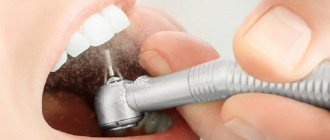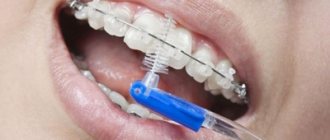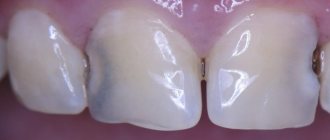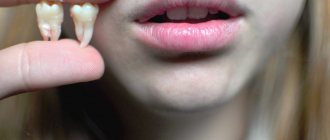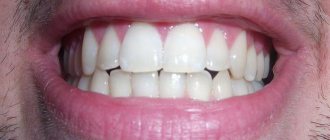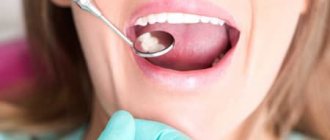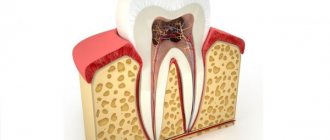There are many reasons why aching pain occurs after filling a tooth. Some of them are not dangerous, but some indicate serious pathologies that require immediate surgical intervention. It is difficult to independently determine the cause of pain, so you should consult a doctor to clarify the diagnosis.
Why does a tooth hurt after root canal filling?
There are serious and non-serious causes of toothache after the installation of a filling, pulp removal and root canal treatment. In the first case, you need to consult a doctor to eliminate the negative factor that provokes the pain. In the second, it is enough to wait a while, and the unpleasant sensation will go away on its own.
Non-hazardous reasons
If during dental procedures the nerve was not removed, but the root canals or gums were injured, then the pain that arises after the procedure goes away on its own. Unpleasant sensations can be caused by:
- too cold or hot food;
- sweet products;
- hypothermia;
- nervous overstrain;
- intensive cleaning;
- strong mechanical load.
In the first days after filling, the tooth should not be overloaded, as there is a high risk of aching pain and damage to hard tissues - it is better to chew on the other side.
The dentist must warn the patient about the possible occurrence of pain before performing surgical procedures. After filling, the tooth always hurts, and nothing needs to be done about such pain. The main thing is to follow all the doctor’s recommendations and not interrupt therapy if the doctor has prescribed a repeat visit.
Medical errors
If an X-ray examination was not performed before installing the filling, the dentist could confuse deep caries with pulpitis. Then the doctor will not clean the canals and eliminate the cause of the pathology. Until the pulpitis is cured and the nerve is removed, the pain will not stop. If the disease is advanced, the tooth will have to be pulled out. Otherwise, inflammation can move from hard to soft tissues, which cannot be determined using x-rays, especially in the early stages.
If the filling is placed well, but it still hurts for a person to press on the tooth and chew food, you can suspect the presence of a foreign object in the tooth. When treating the canals and dental cavity, part of the thin dental instrument could break off and remain inside, which is why the tooth became sick. You can see a foreign object using an x-ray.
Pain could occur after tooth canal filling if the dentist did not properly clean the carious cavity and did not neutralize the infection. If during treatment the cleaned tooth canals were not cooled using the air-water method, they could overheat, since manipulation with a drill always leads to overheating of soft and hard tissues, which is fraught with the development of pulpitis or periodontitis.
After filling the canals, the material ended up outside the root
Incorrect filling size
If a toothache appears after or during a meal, it means that the tooth filling was performed incorrectly. The dentist may have placed an improperly sized filling on the chewing teeth. And it can be:
- too small - there is an unfilled space inside, which can only be seen on an x-ray;
- too large - the filling does not allow the jaw to close tightly and interferes with biting and pressing.
For some time after the anesthesia procedure, the patient cannot feel discomfort from the new filling; pain occurs later. In this case, the filling needs to be replaced, since it will injure the tissues that surround the root every time you press on the tooth.
To avoid dental problems caused by the doctor, you should look for a specialist based on recommendations, but even paid treatment does not guarantee the absence of medical errors.
Allergic reaction to material
Silver amalgam is usually used to make fillings, and a person may be allergic to this substance. In this case, in addition to pain, the following are observed:
- itching;
- skin rash;
- asthmatic attacks;
- swelling of the gums in the projection of the inflamed area (the skin also hurts).
If the pain is caused by an allergic reaction to the anesthesia, it will disappear the next day. Otherwise, the tooth is filled with a composite material, but this procedure is provided for a fee.
Toothache after root canal filling can occur due to prolonged etching of dentin with acid: the chemical damages the dentin canals. After this, the filling material penetrates the dentinal tubules and irritates the pulp, causing pain.
TOP causes of post-filling pain in patients
- A filling that is too high for the bite
. A situation where the filling material protrudes beyond the boundaries of the crown. Sometimes the problem resolves itself, i.e. After some time, the patient gets used to it and the filling “grinds in.” For this reason, a person turns to the doctor who performed the filling, and the filling is “adjusted” to the bite. - The effect of light curing agents on the pulp during treatment
. The reason is when the powerful light flux emanating from the lamp leads to certain morphological changes in the tooth pulp and it can become very painful. Among them are swelling of the stroma, microhemorrhages and other biological processes that provoke periodic tooth pain. - Incorrect channel processing
. They were poorly processed, imperfectly sealed, and areas of tissue inflammation remained. There is also a risk of existing voids in the canals, where pathogenic bacteria can penetrate over time and provoke a more global inflammatory process already in the canals. - Feeling of a filling being pressed inside
. A common reason is when the patient, due to the effect of the anesthetic, did not indicate this point at the filling stage. - Shrinkage of the filling after treatment or polymerization stress
. A phenomenon in which, after being installed in a patient, the filling shrinks and begins to put pressure on the walls of the teeth - they begin to hurt. Tension is created inside the tooth, which causes pain. Sometimes polymerization stress is caused by mistakes made during the “glowing” of the composite material. In these cases, it is also necessary to consult a doctor - often replacing the filling is required to correct the error. - Complex treatment of tooth canals
. In these cases, post-filling pain is quite understandable, since the doctor performed extensive work on cleaning, processing and filling the tooth canals. They were expanded, “disturbed” by the instrument - therefore, the body’s natural reaction to outside interference manifests itself. If pain continues for about two to three weeks after treatment, it is no longer normal.
Classification of pain sensations
The cause of pain can be determined by its intensity:
- Increased sensitivity to sweet, cold and sour foods is observed when a low-quality or temporary filling is placed.
- Severe and throbbing pain indicates the development of acute pulpitis, which requires emergency dental treatment.
- The phenomenon when a tooth ache occasionally is the norm after filling. But sometimes such pain syndrome signals chronic pulpitis or periodontitis.
- If it hurts when biting or pressing, you need to identify an error made during the filling process, for example, dryness of the dental cavity. But such a symptom will go away on its own over time, and therefore does not require specialized medical intervention.
- If you have reddened gums along with aching toothache, you can suspect an allergic reaction to the filling material, but before taking antihistamines, you should consult your dentist again.
If pain occurs, you should not stop brushing your teeth; you can only reduce the intensity of the pressure.
Can pain after filling be normal?
Tooth pain that develops after treatment is a completely natural phenomenon, but its appearance can also signal the progress of a pathological process. How to distinguish between these two states?
When the pain appears immediately after the end of the manipulations and the cessation of anesthesia, and is aching in nature, subsiding over time, then we can talk about a normal reaction to the filling.
If paroxysmal pain develops after several days and sometimes weeks, one should suspect that complications have developed. This may be secondary caries, pulpitis or periodontitis.
To cope with the pain reaction that appears after a visit to the dentist, you can take a painkiller tablet.
When to Visit a Dentist Immediately
If your tooth hurts for a long time after root canal filling, you should consult a doctor. Moreover, the nature of the pain is not important. If the unpleasant sensations in a dead tooth have not gone away within a week or two, you cannot tolerate them any longer.
If you experience acute pain after installing a filling, you should go to the doctor immediately. Severe discomfort may indicate periodontal disease or pulpitis, and such diseases require urgent surgical intervention .
If the tooth is not removed, the infection will soon become generalized and the temperature will rise sharply. Then the infection will spread through the bloodstream, reaching the maxillary sinuses, and perhaps even the brain, which is fraught with serious consequences for human health and life.
Treatment
To eliminate the causes of pain, you should definitely contact your doctor. And the sooner you do this, the less likely it is to develop complications.
If your tooth hurts after having a filling installed due to caries or pulpitis, treatment will consist of drilling out the old composite, completely cleaning and disinfecting the damaged cavity, and refilling it.
With periodontitis, treatment will take longer, since repeated treatment of inflamed tooth and gum tissues with antiseptic drugs is necessary. Treatment of cysts involves exclusively surgical intervention. Recently, many clinics have begun to use a laser device for these purposes, which makes the procedure virtually painless.
In case of an allergic reaction, the only treatment is to replace the filling substance with another that does not cause harm to the body. In all other cases, only the doctor who performed the initial treatment will be able to determine why the tooth hurts after a filling and how to deal with it. All that is required on your part is an immediate response to the problem and an appointment with a specialist.
Can I take medications?
With severe pain syndromes, many rush to take antibiotics and anti-inflammatory drugs, for example, Nimesil, but taking medications without a doctor’s prescription is fraught with serious consequences. Antibacterial therapy will only temporarily eliminate the source of infection.
For example, the same Nimesil is an effective anti-inflammatory drug. But it is used in dentistry only when the dead tooth has been filled correctly, and it is not advisable to open it. Taking Nimesil is justified only in extreme cases, since the medication has a lot of contraindications and side effects.
You should not delay visiting the dentist and treat the disease with self-selected medications. If you need to remove a tooth to get rid of pain, pills will not save the situation.
What analgesics can you take?
If a person has a toothache with sealed canals, then under no circumstances should you start taking an anesthetic and analgesic. Medicines will relieve pain, but not the cause of inflammation. And this can lead to serious complications, including death.
In some cases, you can use traditional medicine, since they do not have side effects and do not have such a strong analgesic effect, and therefore will not allow you to ignore a serious illness.
To relieve discomfort, you can rinse your mouth:
- anti-inflammatory saline solution with soda;
- herbal infusion of chamomile, lemon balm, sage or yarrow;
- soda solution with a small addition of iodine.
Salt and pepper
If the reasons why a tooth hurts after installing a filling are not related to inflammatory processes in the oral cavity and are temporary, the discomfort can be eliminated with a mixture of salt and pepper. Spices are mixed in one to one proportions and diluted with water until a homogeneous paste is formed. After this, the mixture is applied to the inflamed area.
Medicinal herbs
Cloves help cope with tooth pain. The plant has the following properties:
- anesthetic;
- antibacterial;
- anti-inflammatory;
- antioxidant.
To prepare a clove “medicine”, you need to chop the flowers in the amount of 2-3 heads and mix them with vegetable oil, and then rub the resulting mixture into the gum and apply it to the aching tooth.
Ready-made clove oil also helps in the fight against pain. You should drop it into a glass of water (about 5-7 drops per 200 grams of liquid) and rinse your mouth with the resulting solution.
You can chew a piece of propolis or zabrus, as these honey products have a strong analgesic and anti-inflammatory effect. If the pain is localized in one area of the gum, you can put a little cosmetic clay on it. It is better to do this manipulation before going to bed, since the clay crumbles. To get rid of its remnants, you should brush your teeth and rinse your mouth.
If after all the manipulations the tooth continues to hurt, you need to visit the dentist: the symptom could appear due to pulpitis or periodontal disease, and they cannot be cured with clay and cloves.
Simple folk remedies will help relieve pain if its cause is harmless, but even in more serious pathologies they will not cause harm. If your gums swell and hurt in the first days after filling a tooth, you can try to relieve the inflammation yourself. But if symptoms persist for a week, you need to go to the doctor.
Prohibited methods of self-medication
The use of inappropriate and even dangerous methods of self-medication can lead to serious consequences and complications. When your tooth hurts, you should never:
- give injections of medications into the gums;
- open soft tissues, trying to extract pus;
- warm up and rub the tooth with alcohol-containing drinks, since thermal procedures will provoke the spread of infection;
- try to remove a filling yourself, even a temporary one, since this is not only ineffective and painful, but also dangerous to health;
- constantly press and press on the painful area;
- apply ice to the gum;
- treat the disease with antibiotics without a doctor's prescription.
How long does a tooth hurt after filling?
Filling is performed under anesthesia. When the anesthesia wears off, patients always feel discomfort when pressing on the treated tooth. For several days after visiting the doctor, pain may be observed when pressing on the tooth and during other mechanical influences, including chewing, and sometimes reactions to too cold or hot food appear - all these phenomena are natural.
Any dental procedure is a minor surgical operation, so it is natural that tissue healing occurs after it. If you press on a wound on the knee or a post-operative suture, the person will also feel pain. But after filling and canal treatment, a tooth cannot hurt for a long time.
If the discomfort does not disappear 4-5 days after visiting the clinic, you should visit the doctor again. If the tooth does not get sick immediately, but some time after the filling is installed, the symptom may indicate the development of an inflammatory process. You should pay due attention to your health if unpleasant sensations appear for a long time and mainly at night or in the evening.
How does cervical caries develop?
Cervical caries develops in several stages. At each stage it is characterized by its own clinical picture.
- First stage: spot stage. A small stain forms on the surface of the tooth. It may not change in shape and size for a long time. With this form there is no pain. But sometimes a sore throat may appear, especially from taking sour or other irritants. The color of the spot can be white or pigmented. The shade depends on the speed of development of caries and its staining with food dyes. The enamel itself becomes thinner and acquires a matte tint. But it still feels smooth. The first stage of the disease is treated conservatively; drill preparation is not used here.
- Second stage: superficial cervical caries. The spot becomes rough. The process of destruction of the enamel begins. Painful sensations that appear from various irritants: sour, sweet, spicy foods and drinks begin to bother you. There have been cases when the stage of superficial caries was asymptomatic. This stage is characterized by fairly rapid progression of the disease.
- Third stage: middle cervical caries. A carious cavity forms here. Dentin and enamel are simultaneously affected. The defect is very noticeable visually. The pain becomes much more intense.
- Stage four: deep cervical caries. The disease penetrates into the deepest tissues, which are located next to the neurovascular bundle. Caries affects the pulp and dental canals. The patient begins to suffer from unbearable pain, which intensifies at night. A person also begins to feel pain when inhaling cold air.
